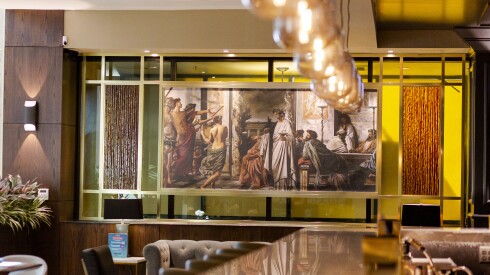Is it even possible to travel unplugged in 2025? Since Afar ran a campaign to encourage travelers to explore device-free in 2018, smartphones have gotten smarter and even more present in our lives. Americans spend an average of 4.5 hours per day on them, up from just under three hours in 2022. It’s harder than ever to power down, but it’s worth trying: Studies show that less screen time can improve your mental health, provide more space for big-picture thoughts, and help you travel more deeply.
Disconnecting “resets your nervous system and allows you to be more present with your thoughts,” says Chip Conley, founder of the Joie de Vivre hotel chain and the Modern Elder Academy, which offers midlife retreats aimed at helping people find purpose and inspiration at a certain age. “It also allows you to be more present to cultivating awe—to see the world differently.”
In The Psychology of Travel (Routledge, 2023), Dr. Andrew Stevenson shares how travel can make us happier, especially if we foster a state of mindfulness and flow. That can be achieved by experiencing places through the senses directly, he tells me, by dancing, cooking, or visiting a gallery—“things associated with the offline experience, multisensory rather than digital.”
Prepare for a more analog trip
Conley says you need to do three things to disconnect with impunity: Set an out-of-office message “that gives you comfort that others can support you while you’re offline and doesn’t make you feel guilty for not being expeditious in your response”; make sure that people know the boundaries you’d like to create for the trip; and consider “alternative ways of doing something that doesn’t require technology.”
There are practical ways to prepare. First, delete apps you love or fear (Whatsapp and Slack in my case); buy a paper journal; set bills on autopay; and ask a neighbor to keep an eye on the house. But perhaps the most important preparation happens in your mind.
Stevenson says that travelers tend to fall into one of two categories, present focused and future focused. The former “find it quite easy to just fully immerse themselves and enter a flow state in a new situation,” not worrying about Monday’s To Do list. The latter “find it hard to switch off”; they’re the ones checking emails on the beach, he says. He recommends being future focused before you set off and present focused when on the trip, such as keeping a written diary while you’re away or setting aside five minutes to think about your everyday commitments then putting them out of your mind.
Be realistic about your time
When, where, and how long you unplug during a trip is up to you. “A few hours or even minutes unplugged can bring fresh perspective and renewed energy,” says Anna Bjurstam, who heads up Six Senses’s global wellness initiatives. For a serious session, head to a silent retreat or a region with no Wi-Fi. That “can solve the problem for you,” Conley says.
You can also look for a hotel that facilitates off-screen time. Miraval Resorts & Spas encourages digital mindfulness and provides guests with “cell phone sleeping bags,” paper pads and pens for note taking, and a map of where on-site phone usage is permitted. Signs remind guests to unplug. At Six Senses, guests can hand their phones in at reception, “giving themselves permission to fully disconnect for a few hours,” Bjurstam says.
I find it easiest to disconnect in small doses, going into “sleep mode” where I’m offline but contactable. I’ve temporarily switched my iPhone to a Light Phone, a “dumb phone” that mostly just offers basic texting and calls, and used a pay-as-you-go handset for foreign travel, which also saves on roaming costs. My laptop stays in a closet, ready to spring into action if needed.
Get personal
How to resist the temptation to look up info or intel on your phone while traveling? Lisa Abend has a few ideas. In 2024, the Afar contributor launched The Unplugged Traveler newsletter. In it, she visits a new place each month with no help from the internet (either before or during the trip), aiming to bring back a bit of the magic of travel.
Abend recommends seeking out a tourist office for free maps, asking to see hotel rooms before booking, and, most importantly, talking to people—about directions, good restaurants, or if they live in the neighborhood and can recommend must-sees. “You’d be surprised how often those kinds of interactions lead to more substantive conversations,” she says. “That’s where the real serendipity happens.”











